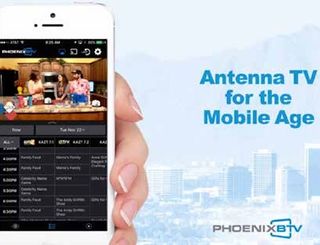Can PhoenixBTV Succeed Where Aereo Failed?

Aereo crashed and burned amid bankruptcy and a big loss in the Supreme Court, but there’s still no shortage of other legal options that have emerged to help consumers stream local broadcast TV to their connected devices.
The latest to join the mix is Didja Inc., which last week unleashed a beta service in the Phoenix area that delivers dozens of channels from local broadcast- TV partners.
Billing it as “antenna TV for the mobile age,” Didja’s Phoenix-area trial captures the over-the-air TV signals of select local broadcasters and streams them to Web browsers, as well as market-branded apps for Android and iOS smartphones and tablets. Users can also watch the service, called PhoenixBTV, on television sets using a Google Chromecast streaming adapter or via Apple TV using AirPlay.
PhoenixBTV is starting out as a free, consumer beta that streams in more than 20 channels. Didja, which has a cloud DVR feature on its product road map, said it also has plans to offer a paid premium version of the service that will deliver more than 50 channels of local TV.
Notably, the service is only for Phoenix metro residents and won’t work for people outside that TV market, the company said.
NO BIG FOUR YET
PhoenixBTV currently offers a mix of local stations and broadcast diginets such as AZTV, MeTV, TuffTV, This TV, Retro TV, Rev’n, Azteca and Estrella TV, among others. However, it does not yet offer access to local affiliates of the Big Four networks, ABC, NBC, CBS and Fox.
Broadcasting & Cable Newsletter
The smarter way to stay on top of broadcasting and cable industry. Sign up below
Jim Long, Didja’s CEO, said his company is also trying to negotiate for more programmers to be part of PhoenixBTV.
Didja’s trial offering might conjure up memories of Aereo, the now-defunct OTT service for cord-cutters that captured and redistributed local broadcast-TV channels to broadband-connected devices. Aereo in 2014 lost a Supreme Court battle in which several broadcasters argued that the OTT service violated copyright laws by delivering TV-station signals remotely over the Internet without compensating content providers.
PhoenixBTV is different and legal, Didja said, noting that it has obtained approval to offer its channels for the beta offering. The service also intends to secure the blessing of broadcasters for any additional channels it might add down the road.
Though Didja’s technical approach does involve the capturing of local over-the-air TV signals, Long declined to discuss the architecture of PhoenixBTV in much detail, or how it was similar or dissimilar from Aereo’s. Long also would not get into the business relationships his company has with local broadcasters, but said they are not traditional retransmission agreements.
“We have a philosophy that we want a service that is simple, fast and of high quality,” he said, noting that “fast channel-change” is one area of technical focus.
PhoenixBTV has opened its beta trial to anyone in the Phoenix area who qualifies to receive it, though the company might decide to pause and unpause how many people it allows access to the app during the test period.
“We’re prepared to do the test for as long as it takes, Long said, noting that the hope is that PhoenixBTV will offer a commercial product sometime in 2017.
In addition to the technology, PhoenixBTV will also use the trials to help it get a fix on its audience.
GEARED TO CORD-CUTTERS
PhoenixBTV will largely cater to cord-cutters and cord-nevers, as well as people who want broadcast TV while they are on the go in the market, or simply can’t get local broadcast TV with a regular digital antenna. It also views itself differently than a virtual MVPD skinny-bundle service like Sling TV, because Didja’s focus is on local broadcast.
“We think people are more interested in local TV than some people realize,” Long said.
PhoenixBTV isn’t the only company or service focused on TV station streaming to rise since the fall of Aereo.
For example, Telletopia Foundation, a San Diegobased company, is also looking to offer a legal OTT service that relies on retrans payments and an exemption from the compulsory license for nonprofits, with an original aim of launching national service in 2016.
TabletTV, a joint venture of Granite Broadcasting and U.K.-based Motive Television, is taking a different tack by enabling users to capture over-the-air signals on a small device called the TPod and feed them to nearby connected mobile devices.
Other device makers, including TiVo (Roamio OTA), CloudAntenna, Channel Master (DVR+), and Nuvyyo (Tablo) are targeting cord-cutters with devices that enable users to access OTA channels and over-the-top content.
